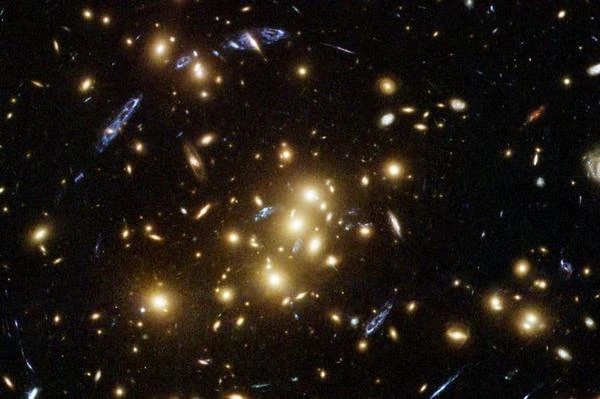
In astrophysics, gravity acts not only on matter but also on light, distorting its path through spacetime. This phenomenon, called gravitational lensing, stems from Einstein's theory of general relativity, according to which a mass curves the geometry of the surrounding spacetime. Thus, when a massive object like a galaxy cluster is situated between a distant light source and the observer, it acts as a natural lens, deflecting and amplifying the light rays. This "gravitational mirage" can produce spectacular effects such as light arcs, Einstein rings, or multiple images of the same celestial object. These distortions not only allow the detection of invisible objects like dark matter but also probe the distant universe with unparalleled precision, revealing galaxies located billions of light-years away.
An illusion that astronomers know well is the Gravitational Lens or Gravitational Mirage. A massive object, such as a galaxy cluster, situated between an observer and a distant light source, imprints a strong curvature (deformation) on spacetime. This has the effect of deflecting all light rays that pass near the object, thus distorting the images received by the observer.
This amplification of the brightness of a distant celestial object by a massive star in front was predicted by the theory of general relativity in 1917. Massive objects modify the geometry of space and time in their vicinity. Light, on the other hand, always takes the shortest path, but in a curved space modified by the presence of a gigantic mass, the shortest path is not a straight line. The path of light rays curves near massive stars. Most of the galaxy images in this photograph are multiple images of a single ring galaxy.
A giant galaxy cluster in the foreground acts as a huge gravitational lens. In the foreground, the galaxies of this cluster appear in yellow, and the galaxy observed behind appears in blue at the center. A gravitational lens can generate multiple images of background galaxies.
The unique shape of the background blue galaxy (small blue spot in the center of the image) allowed us to deduce that it is the same one we see at 4 o'clock, 10 o'clock, 11 o'clock, and 12 o'clock. The analysis showed that at least 33 images of 11 different background galaxies are discernible in this image. This spectacular photo of the galaxy cluster CL0024+1654 was taken by the Hubble Space Telescope in November 2004.
Predicted by Albert Einstein's Theory of General Relativity (1879-1955), several gravitational mirages have since been observed by Hubble. When the alignment between two objects is perfect, the image of the distant object can take the form of a luminous ring surrounding the nearby object.
In the case of a perfect alignment between the observed source (a star, for example) and another stellar object (a black hole, for example), the black hole in front will act as a gravitational lens or deflector. The observer will no longer see the star as such but rather as a ring; this ring is named the Einstein Ring.
A star, although having a mass much lower than that of a galaxy, can also act as a gravitational lens. The effect is obviously much less powerful; it is then called a microlens.
1997 © Astronoo.com − Astronomy, Astrophysics, Evolution and Ecology.
"The data available on this site may be used provided that the source is duly acknowledged."
How Google uses data
Legal mentions
English Sitemap − Full Sitemap
Contact the author